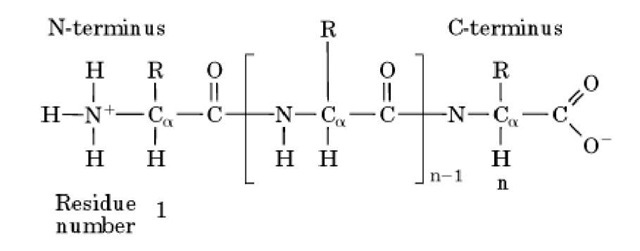
If you look carefully, you will spot the abbreviations for glycine (Gly) and alanine (Ala) amongst the others. Using three letter abbreviations, a bit of a protein chain might be represented by, for example: These abbreviations commonly consist of three letters or one letter. This primary structure is usually shown using abbreviations for the amino acid residues. In other words, if you replaced the "R" groups in the last diagram by real groups you would have the primary structure of a particular protein. Now there's a problem! The term "primary structure" is used in two different ways.Īt its simplest, the term is used to describe the order of the amino acids joined together to make the protein. I mention this for the sake of completeness - not because you would be expected to know about it in chemistry at this introductory level. In this case, the hydrogen on the nitrogen nearest the "R" group is missing, and the "R" group loops around and is attached to that nitrogen as well as to the carbon atom in the chain. Note: In the case where the "R" group comes from the amino acid proline, the pattern is broken. The peptide chain is known as the backbone, and the "R" groups are known as side chains. The "R" groups come from the 20 amino acids which occur in proteins. The end of the peptide chain with the -NH 2 group is known as the N-terminal, and the end with the -COOH group is the C-terminal.Ī protein chain (with the N-terminal on the left) will therefore look like this: The unchanged -COOH group is written at the right-hand end. The peptide chain is made up from what is left after the water is lost - in other words, is made up of amino acid residues.īy convention, when you are drawing peptide chains, the -NH 2 group which hasn't been converted into a peptide link is written at the left-hand end. When the amino acids combine together, a water molecule is lost. You have to use this term because strictly speaking a peptide chain isn't made up of amino acids. If you joined lots and lots together (as in a protein chain), you get a polypeptide.Ī protein chain will have somewhere in the range of 50 to 2000 amino acid residues. If you joined three amino acids together, you would get a tripeptide. In chemistry, this would also be known as an amide link, but since we are now in the realms of biochemistry and biology, we'll use their terms. In each case, the linkage shown in blue in the structure of the dipeptide is known as a peptide link. It is possible for this to happen in one of two different ways - so you might get two different dipeptides. Glycine and alanine can combine together with the elimination of a molecule of water to produce a dipeptide. That means that the two simplest amino acids, glycine and alanine, would be shown as: It is much easier to see what is happening if you do that.

However, for drawing the structures of proteins, we usually twist it so that the "R" group sticks out at the side. In chemistry, if you were to draw the structure of a general 2-amino acid, you would probably draw it like this:

IB students should ask the advice of their teacher or lecturer.

I suspect what is wanted is fairly trivial. Note: Quaternary structure can be very complicated, and I don't know exactly what depth the IB syllabus wants for this (which is why I haven't included it).

There is a mention of quaternary structure on the IB chemistry syllabus, but on no other UK-based syllabus at this level. It only applies to proteins consisting of more than one polypeptide chain. This page explains how amino acids combine to make proteins and what is meant by the primary, secondary and tertiary structures of proteins.


 0 kommentar(er)
0 kommentar(er)
